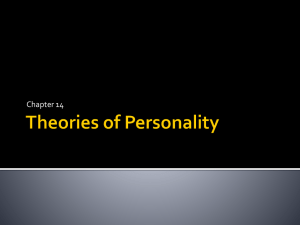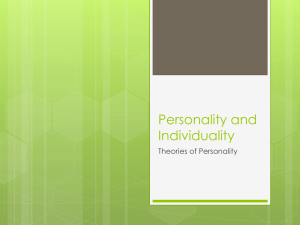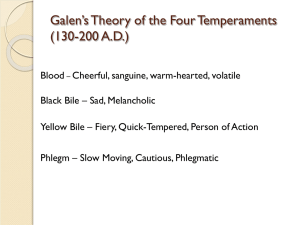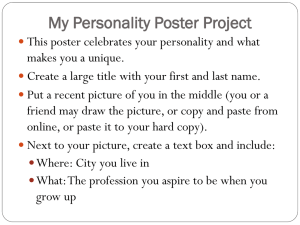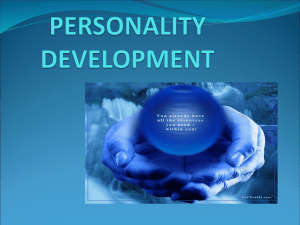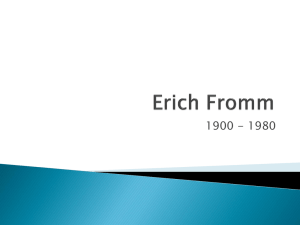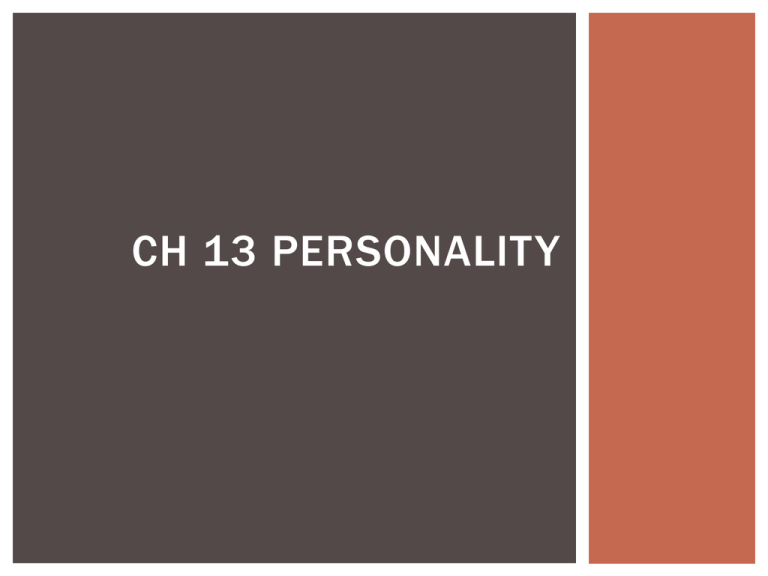
CH 13 PERSONALITY
PERSONALIT Y
Unique way in which each individual thinks, acts, and feels
throughout life
It is not
Character – person’s value judgments made on a person’s morals or
ethical behavior
Temperament – enduring characteristics with which each person is
born, such as irritability or adaptability
Biology through genetic and prenatal influences
One’s larger personality is built on this
PERSPECTIVES OF PERSONALIT Y THEORY
Psychodynamic
Sigmund Freud
role of the unconscious mind and biological causes of personality
Behaviorist
Effect of environment on personality
Humanistic
Reaction against psychoanalytic and behaviorist
Role of each person’s conscious life experiences and choices
Trait
End result, not focused on causes
SIGMUND FREUD
Born in 1856
Grew up in Vienna
Jewish, so he then moved to England to escape Nazis
Victorian age, sex only in marriage, and you should not like it
Many of Freud's patients were wealthy women with sexual
repression
Freud was obsessed with sex being the explanation for
abnormal behaviors
UNCONSCIOUS MIND
Three parts of a persons’ mind
Preconscious, conscious, and unconscious mind
Unconscious mind
Level of the mind that we keep thoughts, feelings and memories.
Not easily or voluntarily brought into consciousness
To Freud it is what makes up our personality and human
behavior
DIVISIONS OF PERSONALIT Y
ID-if it feels good do it
Pleasure seeking, immoral
Basic biological drives
Hunger, thirst, self preservation and sex
Pleasure Principal – desire for immediate gratification with no regard
for the consequences
Ego-the Executive Director
Rational, logical and conning
Reality Principal - satisfying the needs of the ID when negative
consequences will not result
Superego- the moral watchdog
Moral Center
Contains the Conscience, what makes up feel guilty
HOW THEY WORK TOGETHER
Psychological defense mechanisms
How our unconscious distorts our perception of reality to reduce
stress and anxiety
Examples
Denial
Repression
rationalization
STAGES OF PERSONALIT Y DEVELOPMENT
Freud determined 5 stages
Developing sexuality of the child
Each stage focus on a dif ferent erogenous zone
Fixation
Getting stuck in one stage
Child will grow but will carry emotional baggage from one stage
ORAL STAGE
Birth to 1 ½ years old
Mouth is the erogenous zone
Weaning is the primary conflict
Fixation in adults
Overeating
Drinking
Smoking
Excessive talking
ANAL STAGE
1 ½ - 3 years of age
Erogenous zone is now the anus
Toilet training becomes an issue
Fixation
Anal Explosive
Messiness is a statement of control
Destructive
Hostile
Anal Retentive
Stingy
Stubborn
Excessively neat
PHALLIC STAGE
3-6 years old
Erogenous zone is the genitals
Realizing dif ferences between boys and girls
Oedipus/Electra Complex
Fixation
Immature sexual attitude
Promiscuous
“mama’s boys”
LATENCY STAGE
6 – onset of puberty
Children hide their sexual feelings
Children grow and develop intellectually, physically and
emotionally
Play with own gender, other gender is bad
Fixation
Difficulty getting along with others
GENITAL STAGE
When puberty begins
Sexual feelings can no longer be hidden
Bodies are changing
Begins adult social and sexual behavior
Fixation
Immature love relationships
CRITICISMS
He did no experiments to arrive at his conclusions about
personality
Used observations and case studies
He used confirmation bias
Memories and dreams would be put into his theory as he needed
No scientific basis of dreams
PSYCHODYNAMIC TODAY
His concepts remain useful
Basis for modern personality theories
Defense mechanisms has drawn much research
Unconscious mind
BEHAVIORIST
Watson and Skinner
Operant and classical conditioning influence our personalities
Our personality is just a set of learned habits
Social Cognitive learning Theorists
Importance of both the influences of other people’s behavior and of a
person’s own expectancies on learning
Observations
Modeling
BANDURA
Three factors in the behaviors that make up a persons
personality
Environment
Behavior itself
Personal or cognitive factors
Reciprocal Determination
The three factors affecting
one another in a give-take
relationship
ROTTER
Motivation
People are driven to seek reinforcement and to avoid punishment
Personality is a relatively stable set of potential responses to
a situation
Locus of Control
We assume we either have or do not have control, internal or external
Expectancy
An expectation that a behavior will lead to a reinforcement
BEHAVIORISTS TODAY
Limited
Does not take mental process into account
Does not look at social influence
Has influenced therapies based on learning theories
HUMANISTIC
Maslow and Rogers
Focuses on what makes us human, unique
Feelings and freedom of choice
ROGERS
We are striving to fulfill what our genetic makeup will allow us
to
Self-actualization=fulfillment
Self concept is our own image of who we are
Real self – who we are
Ideal self – who we want to be
CONDITIONAL AND UNCONDITIONAL
POSITIVE REGARD
Positive regard
Warmth, affection, love
Unconditioned positive regard
No strings attached
Conditioned positive regard
Strings
Fully functioning person
In touch with their own feelings and abilities, trust themselves
HUMANISTIC TODAY
Ignores the negative aspects of human nature
Dif ficult to test
Development if therapies to promote self growth and a better
understanding of self
TRAIT
Concerned describing personality and predicting behavior
Trait – is a consistent, enduring way of thinking, feelings, or behavior
ALLPORT & CATELL
Found 200 traits in dictionary
Paired down to surface or source traits
Reserved vs outgoing
Submissive vs dominant
Shy vs bold
These traits were wired in the nervous system to guide our
behavior
Used in many different situations
Persons “constellation” of traits are unique
Lack of scientific evidence
However, behavioral genetics support heritability of personality traits
THE BIG FIVE
5 trait dimensions
Openness
Conscientiousness
Extraversion
Agreeableness
Neuroticism
TRAIT TODAY
Traits will not always be expressed the same
Depends on situation
The big 5 has been tested
Found in 11 different cultures
ASSESSMENT OF PERSONALIT Y
Interviews – asking questions of the person, structured or not
Halo Effect – interviewer to allow positive traits to influence the
assessment
Projective tests
Psychoanalysts want to uncover the unconscious conflicts, desires
and urges
These tests have the person project their “issues” unto harmless
stimuli
Client responds to whatever comes to mind
Uncovers problems in personality
RORSCHACH INKBLOTS
Developed in 1921 by a Swiss Psychiatrist
10 inkblots, 5 black and white, 5 color
Using predetermined responses based on past answers,
people were given a score
They are still used today
No right or wrong answers
Issues
Subjective
Not reliable
RORSCHACH INKBLOTS
RORSCHACH INKBLOTS
PERSONALIT Y INVENTORIES
Standardized test with yes or no questions
More reliable as the questions are not open ended, and
everyone gets asked the same questions
Myers Briggs is used to assess personality to help with career
selection
MMPI-2 very common
True or false answers to statements
Issues
Some people are able to fake the answers


